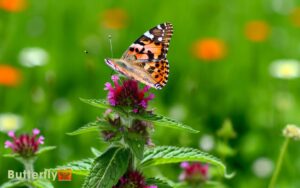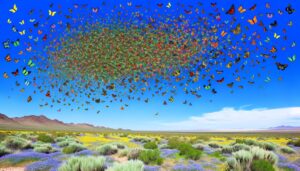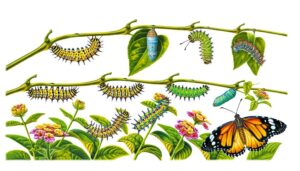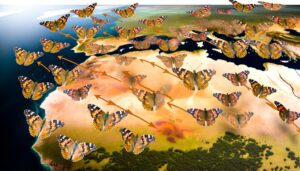Painted Lady Butterfly Chrysalis Stage: A Complete Guide!
The Painted Lady butterfly’s chrysalis stage is marked by the caterpillar securing itself in a ‘J’ shape and shedding its skin to form a chrysalis.
This stage lasts 7 to 10 days, depending on environmental factors like temperature and humidity. Inside, cellular breakdown and reorganization occur as enzymes catalyze tissue transformation.
The chrysalis’ exoskeleton hardens and darkens, providing protection and camouflage. Predators like birds and wasps, along with pollutants, pose significant threats.
As emergence nears, the chrysalis becomes more transparent, revealing adult wing patterns. Observing these stages reveals critical insights into their metamorphic process.
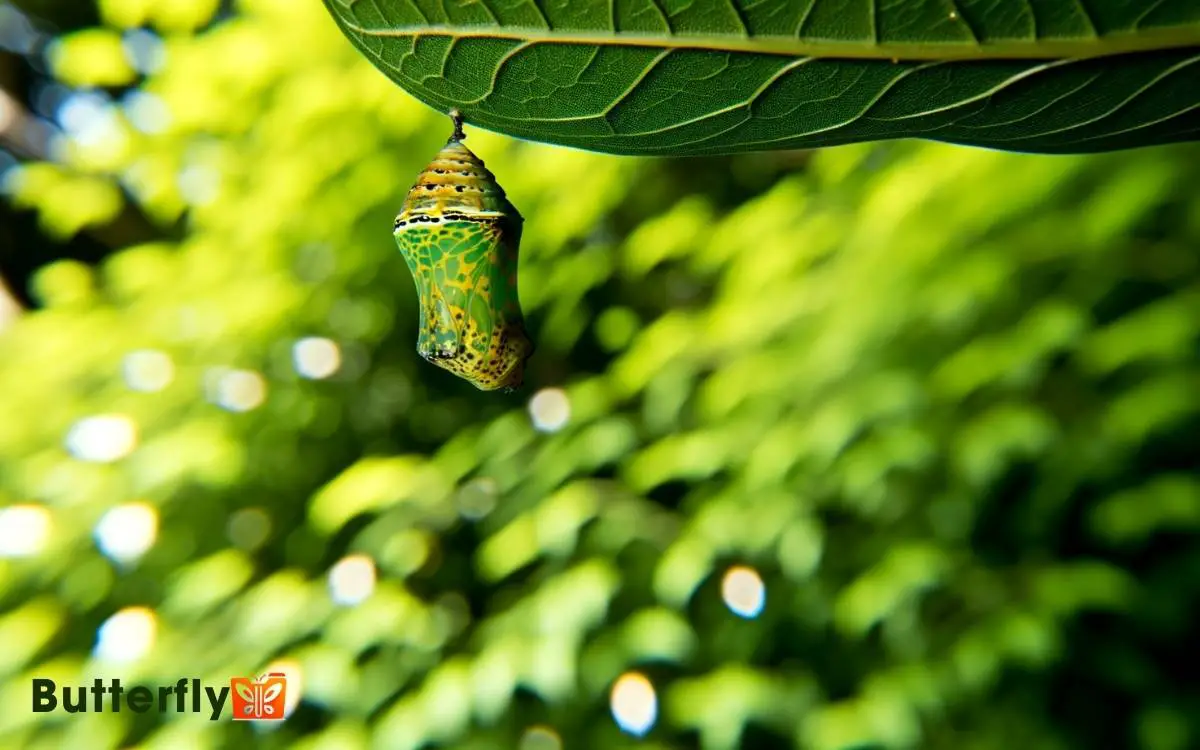
Key Takeaways
Formation of the Chrysalis
The formation of the chrysalis begins when the Painted Lady caterpillar finds a suitable location to attach itself securely.
It selects a sheltered spot, often on the underside of a leaf or a stem. Using a silk pad spun from its spinneret, the caterpillar anchors itself via its last pair of prolegs, forming a ‘J’ shape.
This stage, known as pre-pupation, involves the caterpillar shedding its skin one final time. Beneath this molted layer, the chrysalid is revealed. The transformation is meticulously timed; the caterpillar’s movements slow, and the exoskeleton hardens into a protective shell.
This exoskeleton, or chrysalis, will serve as a protective casing while the caterpillar undergoes metamorphosis into an adult butterfly.
Duration of the Stage
Typically lasting between 7 to 10 days, the chrysalis stage represents a critical period of metamorphosis for the Painted Lady butterfly. During this time, the chrysalis remains immobile, suspended from a secure surface.
Environmental conditions such as temperature and humidity greatly influence the duration of this stage. Warmer climates tend to accelerate development, while cooler conditions may prolong it.
Observers should note the delicate and intricate outer casing, which hardens shortly after the larva forms the chrysalis. This protective shell conceals the transformative processes occurring within.
The chrysalis stage is meticulously timed to make sure that the emerging butterfly is fully developed and ready for survival. Any disturbances during this period can adversely affect the successful emergence of the adult butterfly.
Physical Changes Inside
During the chrysalis stage, the Painted Lady butterfly undergoes significant tissue reorganization, driven by increased enzyme activity that breaks down old structures.
Simultaneously, new tissues and organs form, orchestrating the transformation from larva to adult butterfly.
Structural hardening dynamics also play an essential role, as the chrysalis shell fortifies to protect the developing butterfly.
Tissue Reorganization Process
Inside the chrysalis, cellular breakdown and reorganization occur as larval structures transform into adult butterfly tissues.
Imaginal discs, which remained dormant in the larva, rapidly proliferate and differentiate into complex adult structures like wings, legs, and antennae.
Hemolymph, the insect’s blood, circulates nutrients and removes waste, guaranteeing efficient reorganization. Histoblasts, specialized cells, migrate and form new tissues.
Concurrently, obsolete larval tissues undergo programmed cell death, or apoptosis, to make way for adult morphology.
The tracheal system, responsible for respiration, also restructures to support the butterfly’s new form. This intricate choreography of cellular events makes certain that the painted lady emerges fully formed and capable of flight, signifying the completion of metamorphosis.
Each step is critical for successful adult development.
Enzyme Activity Increase
Enzymes accelerate biochemical reactions within the chrysalis, catalyzing the breakdown of larval tissues and facilitating the synthesis of adult structures.
Proteolytic enzymes disassemble larval proteins into amino acids, which are then redistributed to form the butterfly’s wings, antennae, and other adult features.
Lipases degrade stored fats, supplying the necessary energy for these transformations.
Concurrently, nucleases cleave DNA from larval cells, allowing genetic material to be recycled for adult cell development.
This orchestrated enzymatic activity guarantees precise morphogenesis, converting the caterpillar’s body plan into that of a butterfly.
Each enzyme operates under ideal conditions, ensuring efficiency in the metabolic processes.
This dynamic enzymatic interplay marks a critical phase in the chrysalis, laying the groundwork for the emergence of the adult Painted Lady butterfly.
Structural Hardening Dynamics
The chrysalis undergoes significant physical transformations, with the outer shell hardening to protect the delicate metamorphic processes occurring within.
Initially pliable, the exoskeleton rapidly solidifies through sclerotization, a biochemical process involving cross-linking proteins. This hardening fortifies the chrysalis against external threats and environmental fluctuations.
Concurrently, internal reorganization intensifies, with imaginal discs differentiating into adult structures such as wings, antennae, and legs.
Hemolymph circulation sustains nutrient distribution, facilitating cellular rearrangement. Chitin deposits also reinforce the exoskeleton, ensuring structural integrity.
Throughout this stage, the chrysalis remains immobile, conserving energy for these intricate transformations.
Protective Mechanisms
Frequently, the Painted Lady butterfly chrysalis employs an array of protective mechanisms to guard against predators and environmental threats.
Its outer layer, known as the exoskeleton, hardens and darkens, creating a robust barrier. This coloration often mimics the surrounding environment, providing camouflage.
Additionally, the chrysalis secretes chemicals that deter ants and birds. It also exhibits minimal movement, reducing detection by visual predators. Microstructures on the exoskeleton surface can reflect and scatter light, adding an element of optical camouflage.
Some chrysalides hang in concealed locations, such as the undersides of leaves or within dense foliage. These strategic defenses collectively enhance the chrysalis’s chances of reaching the adult butterfly stage, ensuring the species’ continued survival and propagation.
Environmental Impact
Environmental conditions play a crucial role in influencing the Painted Lady butterfly‘s chrysalis stage. Habitat and climate are essential factors in its development and survival.
Pollutants, such as pesticides and heavy metals, can adversely impact the chrysalis. This can lead to developmental anomalies or increased mortality rates.
Understanding these factors is crucial for conservation efforts and ensuring the species’ continued viability.
Habitat and Climate Influence
Understanding how habitat and climate influence the chrysalis stage of the Painted Lady butterfly reveals critical insights into its survival and development. Temperature and humidity levels play a crucial role in determining the success of metamorphosis, as extreme conditions can lead to deformities or even mortality. Researchers have observed that unsuitable environmental factors often result in a dead Painted Lady chrysalis, highlighting the delicate balance required for successful pupation. Studying these factors further can help conservationists develop strategies to support butterfly populations in changing climates.
The Painted Lady (Vanessa cardui) prefers diverse habitats, from meadows to urban gardens, yet each environment affects its chrysalis.
Temperature and humidity levels play pivotal roles; ideal conditions include moderate temperatures and stable humidity.
Fluctuations can delay metamorphosis or increase mortality rates. Additionally, microhabitats such as sheltered spots under leaves offer protection from predators and harsh weather.
Climate variability, particularly extreme temperatures, can disrupt physiological processes within the chrysalis, affecting eclosion success.
Researchers observe that even slight changes in habitat conditions can significantly impact the development and emergence of healthy adult butterflies, highlighting the delicate balance required for their lifecycle.
Pollution’s Effect on Chrysalis
Pollutants, such as heavy metals and pesticides, can infiltrate the Painted Lady butterfly’s chrysalis, disrupting essential developmental processes and leading to deformities or increased mortality.
These contaminants interfere with the metamorphosis by altering hormone regulation and enzyme activity, crucial for proper tissue differentiation.
Observations indicate that larvae exposed to polluted environments exhibit irregular pupation times and weakened chrysalides, often resulting in malformed adult butterflies.
Additionally, studies have shown that pesticides, particularly neonicotinoids, compromise the immune response, making the chrysalides more susceptible to pathogens.
Heavy metals, like cadmium and lead, accumulate in larval tissues, causing oxidative stress and cellular damage. Therefore, environmental pollution presents a significant threat to the survival and health of the Painted Lady butterfly during its critical chrysalis stage.
Predators and Threats
Painted Lady butterfly chrysalises face significant threats from various predators and environmental hazards that can drastically impact their survival rates.
Predatory wasps and ants are primary threats, as they can penetrate the chrysalis casing to feed on the developing butterfly. Birds also pose a risk, often consuming chrysalises whole.
Environmental factors such as heavy rainfall and extreme temperature fluctuations can cause the chrysalis to deform or desiccate. Additionally, fungal infections can exploit the moist environment within the chrysalis, leading to fatal outcomes.
Parasitic insects, such as tachinid flies, lay eggs on the chrysalis, resulting in larvae that consume the host from within. These threats collectively underscore the vulnerability of Painted Lady chrysalises during this critical stage of metamorphosis.
Role of the Chrysalis
The chrysalis serves as a protective casing where the larva undergoes a complex metamorphosis, transforming into an adult butterfly.
Within this structure, significant biological processes occur. The larval body breaks down and reorganizes into the adult form through histolysis and histogenesis.
Key functions of the chrysalis include:
- Protection: The exoskeleton shields the developing butterfly from predators and harsh environmental conditions.
- Support: The chrysalis provides structural integrity, allowing the formation of adult features like wings, antennae, and legs.
- Regulation: It maintains a favorable microenvironment for enzymatic activity and cellular differentiation.
These processes ensure the successful change from larva to butterfly, making the chrysalis stage a critical phase in the life cycle of the Painted Lady butterfly.
Signs of Emergence
As the chrysalis approaches the end of its development, subtle changes in color and transparency indicate the impending emergence of the adult butterfly.
The chrysalis darkens, revealing the intricate patterns of the butterfly’s wings beneath its surface. Observers will notice the chrysalis becoming more translucent, allowing glimpses of the vibrant colors inside.
| Stage | Color Change | Transparency |
|---|---|---|
| Initial | Green | Opaque |
| Mid-Stage | Brownish | Semi-opaque |
| Pre-Emergence | Dark brown/black | Translucent |
| Emergence | Dark with patterns | Transparent |
| Post-Emergence | Empty shell | Clear |
These visible transformations are critical indicators. The once solid chrysalis now displays the delicate structure of the emerging butterfly, highlighting the final phase of metamorphosis.
Observing the Process
Careful observation of the chrysalis allows researchers to document the precise moment of transformation as the butterfly prepares to emerge. This stage involves meticulous monitoring to capture critical changes.
Researchers note:
- Color shifts: The chrysalis darkens, revealing wing patterns through the translucent casing.
- Movement: Subtle wriggling signifies the butterfly’s internal struggle to break free.
- Structural integrity: The chrysalis’s surface becomes more fragile, indicating imminent emergence.
These observations provide invaluable data on metamorphosis timing and physiological changes. High-resolution cameras and time-lapse techniques are often employed to record these phenomena accurately.
Conclusion
In the chrysalis stage, the painted lady butterfly undergoes a transformative journey akin to a sculptor shaping a masterpiece.
Over the span of several days, intricate physical changes occur, met with robust protective mechanisms against environmental impacts and predators.
This stage is crucial, as it prepares the butterfly for emergence, indicated by visible signs.
Observing this process reveals nature’s meticulous craftsmanship, showcasing the delicate balance between vulnerability and resilience in the life cycle of the painted lady butterfly.

